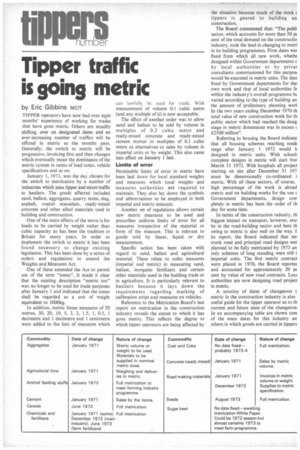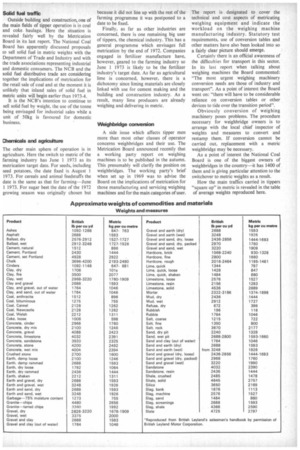Tipper traffic is going metric
Page 54

Page 55

If you've noticed an error in this article please click here to report it so we can fix it.
by Eric Gibbins mcrr
TIPPER operators have now had over eight months' experience of working for trades that have gone metric. Others are steadily shifting over on designated dates and an ever-increasing number of traffics will be offered in metric as the months pass. Generally, the switch to metric will be progressive, invoicing first and then changes which eventually mean the dominance of the metric system in terms of load notes, vehicle specifications and so on.
January 1, 1971, was the day chosen for the switch to metrication by a number of industries which pass tipper and mixer traffic to hauliers. The goods affected included sand, ballast, aggregates. quarry stone, slag, asphalt, coated macadam, ready-mixed concrete and other allied materials used in building and construction.
One of the main effects of the move is for loads to be carried by weight rather than cubic capacity as has been the tradition in Britain for many years. In order to implement the switch to metric it has been found necessary to change existing legislation. This has been done by a series of orders and regulations to amend the Weights and Measures Act.
One of these amended the Act to permit use of the term "tonne". It made it clear that the existing description "metric ton" was no longer to be used for trade purposes after January 1 and indicated that the tonne shall be regarded as a unit of weight equivalent to 1000kg.
In addition, metric linear measures of 50 metres, 30, 20, 10, 5, 3, 2, 1.5, 1, 0.5, 1 decimetre and 1 decimetre and 1 centimetre were added to the lists of measures which
can lawful!) be used for trade. With measurement of volume 0.1 cubic metre (and any multiple of it) is now acceptable.
The effect of another order was to allow sand and ballast to be sold by volume in multiples of 0.2 cubic metre and ready-mixed concrete and ready-mixed cement mortar in multiples of 0.1 cubic metre as alternatives to sales by volume in imperial units or by weight. This also came into effect on January 1 last.
Limits of error
Permissible limits of error in metric have been laid down for local standard weights and measures which local weights and measures authorities are required to maintain. They also lay down the symbols and abbreviations to be employed in both imperial and metric measure.
Another set of regulations allows certain new metric measures to be used and prescribes uniform limits of error for all measures irrespective of the material or form of the measure. This is relevant to goods sold by linear, liquid or dry measurement.
Specific action has been taken with regard to sand, ballast and agricultural material. These relate to cubic measures (imperial and metric) in measuring sand, ballast, inorganic fertilizers and certain other materials used in the building trade or in agriculture. It is particularly relevant to hauliers because it lays down the requirements regarding marking of calibration strips and measures on vehicles.
Reference to the Metrication Board's last report on metrication in the construction industry reveals the extent to which it has gone metric. This reflects the degree to which tipper operators are being affected by the situation because much of the work c tippers is geared to building an construction.
The Board commented that: "The publi sector, which accounts for more than 50 pt cent of the total demand on the constructio industry, took the lead in changing to metri in its building programmes. Firm dates wet fixed from which all new work, whethe designed within Government departments c by local authorities or by privat consultants commissioned for this purposi would be executed in metric units. The date fixed by Government departments for the! own work and that of local authorities le within the industry's overall programme bt varied according to the type of building an the amount of preliminary planning wonl In the two years ending December 1970 th total value of new construction work for th public sector which had reached the desig stage in metric dimensions was in excess .E2500 million".
Referring to housing the Board indicate that all housing schemes reaching ten& stage after January 1 1972 would b designed in metric units. With school; complete designs in metric will start fror March 31 1972. With hospitals all project starting on site after December 31 197 must be dimensionally co-ordinated i metric. With all these sectors, of course, high percentage of the work is alread metric and on building works for the use c Government departments, design coil pletely in metric has been the order of tit day for some time.
In terms of the construction industry, th biggest impact on transport, however, mu! be in the road-building sector and here th swing to metric is also well on the way. I its report, the Board indicated that nel trunk road and principal road designs wet planned to be fully metricated by 1973 an only schemes of long standing were still i imperial units. The first metric contract were placed in 1970, the Board reportec and accounted for approximately 20 pe cent by value of new road contracts. Loci authorities are now designing road project in metric.
A scrutiny of dates of changeover t metric in the construction industry is also useful guide for the tipper operator as to th current and future state of the changeovel In an accompanying table are shown som of the main dates for this industry an others in which goods are carried in tippers Solid fuel traffic
Outside building and construction, one of the main fields of tipper operation is in coal and coke haulage. Here the situation is revealed fairly well by the Metrication Board in its last report. The National Coal Board has apparently discussed proposals to sell solid fuel in metric weights with the Department of Trade and Industry and with the trade associations representing industrial and domestic consumers. The NCB and the solid fuel distributive trade are considering together the implications of metrication for the retail sale of coal and at the moment it is unlikely that inland sales of solid fuel in metric units will begin earlier than 1973-4.
It is the NCB's intention to continue to sell solid fuel by weight, the use of the tonne being envisaged for industrial sales while a unit of 50kg is favoured for domestic business.
Chemicals and agriculture
The other main sphere of operation is in agriculture. Here the switch to metric of the farming industry has June 1 1973 as its metrication target date. For seeds, including seed potatoes, the date fixed is August I 1973. For cereals and animal feedstuffs the date is the same as that for farming—June 1 1973. For sugar beet the date of the 1972 growing season was originally chosen but because it did not line up with the rest of the farming programme it was postponed to a date to be fixed.
Finally, as far as other industries are concerned, there is one remaining big user of tippers. the chemical industry. This has a general programme which envisages full metrication by the end of 1972. Companies engaged in fertilizer manufacture have, however, geared to the farming industry so June 1 1973 is likely to be the fertilizer industry's target date. As far as agricultural lime is concerned, however, there is a dichotomy since timing materials are closely linked with use for cement making and the building and construction industry. As a result, many lime producers are already weighing and delivering in metric.
Weighbridge conversion
A side issue which affects tipper men more than most other classes of operator concerns weighbridges and their use. The Metrication Board announced recently that a working party report on weighing machines is to be published in the autumn. This presumably will clarify the position on weighbridges. The working party's brief when set up in 1969 was to advise the Board on the implications of metrication for those manufacturing and servicing weighing machines and for the main categories of user. The report is designated to cover the technical and cost aspects of rnetricating weighing equipment and indicate the workload on the weighing machine manufacturing industry, Statutory test requirements, use of conversion tables and other matters have also been looked into so a fairly clear picture should emerge.
Certainly there is an offieial awareness of the difficulties for transport in this sector. In its last report when talking about weighing machines the Board commented: "The most urgent weighing machinery conversion needs are those of industry and transport". As a point of interest the Board went on "there will have to be considerable reliance on conversion tables or other devices to tide over the transition period".
Obviously conversion of weighing machinery poses problems. The procedure necessary for weighbridge owners is to arrange with the local chief inspector of weights and measures to convert and restamp them. If conversion cannot be carried out. replacement with a metric weighbridge may be necessary.
As a point of interest the National Coal Board is one of the biggest owners of weighbridges in the country—it has 1400 of them and is giving particular attention to the switchover to metric weights as a result.
How the main traffics carried in tippers "square up" in metric is revealed in the table of average weights reproduced here.










































































































































